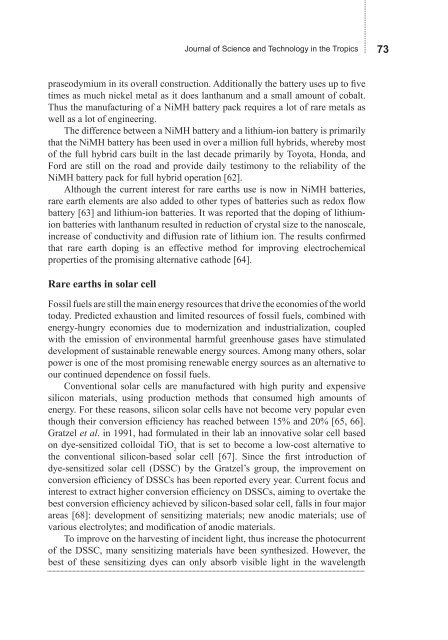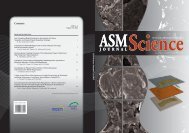Download - Akademi Sains Malaysia
Download - Akademi Sains Malaysia
Download - Akademi Sains Malaysia
Create successful ePaper yourself
Turn your PDF publications into a flip-book with our unique Google optimized e-Paper software.
Journal of Science and Technology in the Tropics 73<br />
praseodymium in its overall construction. Additionally the battery uses up to five<br />
times as much nickel metal as it does lanthanum and a small amount of cobalt.<br />
Thus the manufacturing of a NiMH battery pack requires a lot of rare metals as<br />
well as a lot of engineering.<br />
The difference between a NiMH battery and a lithium-ion battery is primarily<br />
that the NiMH battery has been used in over a million full hybrids, whereby most<br />
of the full hybrid cars built in the last decade primarily by Toyota, Honda, and<br />
Ford are still on the road and provide daily testimony to the reliability of the<br />
NiMH battery pack for full hybrid operation [62].<br />
Although the current interest for rare earths use is now in NiMH batteries,<br />
rare earth elements are also added to other types of batteries such as redox flow<br />
battery [63] and lithium-ion batteries. It was reported that the doping of lithiumion<br />
batteries with lanthanum resulted in reduction of crystal size to the nanoscale,<br />
increase of conductivity and diffusion rate of lithium ion. The results confirmed<br />
that rare earth doping is an effective method for improving electrochemical<br />
properties of the promising alternative cathode [64].<br />
Rare earths in solar cell<br />
Fossil fuels are still the main energy resources that drive the economies of the world<br />
today. Predicted exhaustion and limited resources of fossil fuels, combined with<br />
energy-hungry economies due to modernization and industrialization, coupled<br />
with the emission of environmental harmful greenhouse gases have stimulated<br />
development of sustainable renewable energy sources. Among many others, solar<br />
power is one of the most promising renewable energy sources as an alternative to<br />
our continued dependence on fossil fuels.<br />
Conventional solar cells are manufactured with high purity and expensive<br />
silicon materials, using production methods that consumed high amounts of<br />
energy. For these reasons, silicon solar cells have not become very popular even<br />
though their conversion efficiency has reached between 15% and 20% [65, 66].<br />
Gratzel et al. in 1991, had formulated in their lab an innovative solar cell based<br />
on dye-sensitized colloidal TiO 2<br />
that is set to become a low-cost alternative to<br />
the conventional silicon-based solar cell [67]. Since the first introduction of<br />
dye-sensitized solar cell (DSSC) by the Gratzel’s group, the improvement on<br />
conversion efficiency of DSSCs has been reported every year. Current focus and<br />
interest to extract higher conversion efficiency on DSSCs, aiming to overtake the<br />
best conversion efficiency achieved by silicon-based solar cell, falls in four major<br />
areas [68]: development of sensitizing materials; new anodic materials; use of<br />
various electrolytes; and modification of anodic materials.<br />
To improve on the harvesting of incident light, thus increase the photocurrent<br />
of the DSSC, many sensitizing materials have been synthesized. However, the<br />
best of these sensitizing dyes can only absorb visible light in the wavelength

















